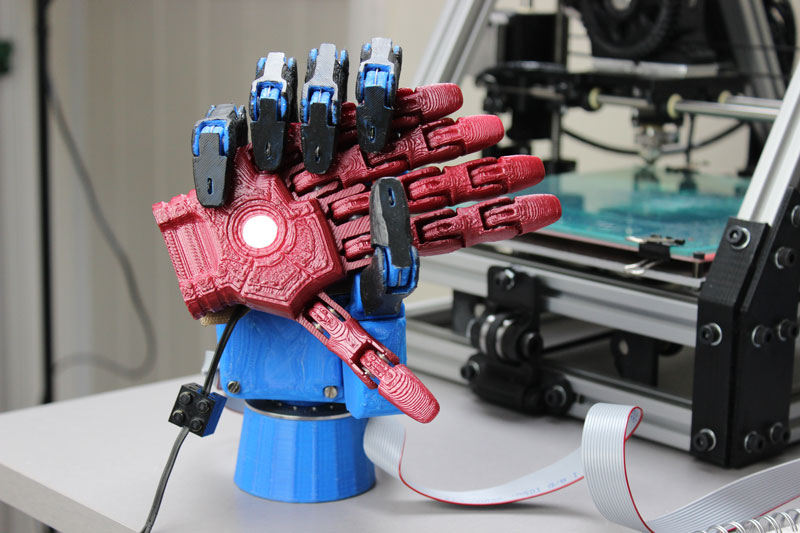Over the past five years, 3D printers have gotten cheaper, hardware has gotten smaller, and tinkerer communities have boomed. All of that has spurred a renaissance of prosthetic design, bolstered by an open source ethos and crowdfunded budgets.
Robotic prosthetics, as you might expect, are still expensive, complicated, and time-consuming to build. But a growing number of designers are pushing to develop prosthetics that can be printed quickly and customised to individual users with a little mechanical know-how. Today, the Dyson Award announced that one of those hands — produced by a group called The Open Hand Project — would be receiving a cash reward as the UK winner of its annual Dyson Award.
The Open Hand Project began when a engineer named Joel Gibbard quit his robotics job and moved in with his parents to focus on developing a cheap, fast robotic hand. Gibbard has spent almost five years on his prototype, called Dextrus, which can be built for under $US1500 (compared to tens of thousands of dollars for custom hands) and which is different from conventional prosthetics in a few ways.
First, the hand is 3D-printed in under 40 hours with plastic that’s super durable, not unlike Lego plastic. Users control it with two EMG sensors — which read the electrical potential of the user’s other muscles to control the hand, readily and cheaply available through shops online — and it can be connected to existing prosthetics so users don’t have to buy entirely new hands to use it. Stainless steel tendons let the plastic “bones” grip and pinch, while tiny motors make it possible to lift and push. Everything’s powered by rechargeable lithium ion batteries.
The project has been around for years now, and has already delivered hands to users through a successful crowdfunding campaign. But Gibbard and his six-person team are pushing forward with funding to keep developing the design, which he explains has undergone an interesting evolution over time. After talking to prosthetic users, the team found that weight and appearance were more important than they expected:
We found that having a light-weight prosthetic trumped having an advanced robotic hand. Amputees were far more concerned with the weight and the look of the hand than they were with the amount of dexterity it had. After discovering this I changed the focus from fine, precise finger movements to aesthetic and weight saving design. I’m now more focused on treating the robotic hands as interchangeable tools and even fashion accessories.
Hand amputees would like prosthetics that are more fashionable and fun. An amputee would want two or three affordable robotic hands, all different colours and designs to wear for different occasions.
The team has focused more on weight and style now, printing colourful versions and eschewing designs that make the hand look more “real.” “Accurately coloured (skin-matched) coatings are typically very expensive and of course there is no “one colour fits all,” Gibbard writes on the Open Hand website. “For this reason the Dextrus will be left uncovered and it’s my hope that users will wear it proudly.”

But what’s really important to mention here is that Gibbard is just one in a growing community of engineers taking on this problem, and that’s a good thing: More brains focused on the same problem — which itself is complex and dependent on each individual user — is a good thing. There’s CyborgBeast, another super-inexpensive open source design available on Thingiverse. Or HACKberry, another open source prosthetic design. RoboHand, yet another open source design, was actually designed by a woodworker who lost two of his fingers in an accident.
Then there’s the emerging technology that’s dovetailing with this engineering boom: The tech necessary to build these hands is also getting smaller and better. It was only last year that the FDA approved the sale of muscle-controlled prosthetics. Meanwhile, the cost and precision of 3D printers are dropping and rising, respectively, every year — in fact, Gibbard told The Telegraph that he will use the Dyson prize money to buy a new printer.
Obviously, we’re at the very beginning of this particular movement. Hardware will improve, as will the engineering knowledge behind these designs and the community of people who are funding the development. For now, Gibbard will get a new printer to produce the next in a long line of prototypes.
